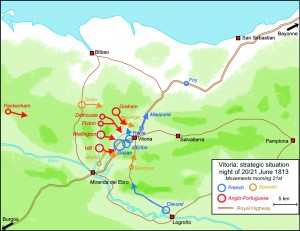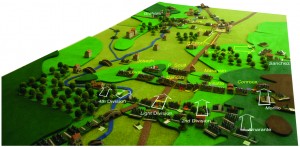I’m thinking aloud about command and control in wargames. My original, over-long piece started to develop thoughts about plans, initiative and how they were influenced by calibre of corps commander. Let’s draw out some general points:
- Plans have an important role in battles in allowing acts of complex coordination and allowing more distant corps to take the initiative. By and large, the side with an active plan holds the initiative.
- Plans take time to draw up, though a strong corps command function, as the French possessed, may speed the process up. They also have a shelf life, as units move under the plan, or as the enemy fights back, the plan loses its power.
- When a plan is weak, corps commanders are liable to behave more erratically. A relationship of mutual understanding and trust is critical between the army and corps commander. Only rarely is this strong (e.g. Napoleon with Davout or Massena) ; very poor relations can happen (Napoleon and Bernadotte) – but most relationships are intermediate, and intentions can get misinterpreted – attacks being too aggressive, for example.
These thoughts started to come out of an examination of the battle of Wagram. Since that was a profitable exercise, let’s look at some others. While I have a rough idea about a lot of battles, I have a deeper understanding of only a few. But that’s a start. Let’s do Waterloo first.
- It starts with a curiosity. There is a 7-8 hour gap between first light and Napoleon getting the battle started. The French army started the day somewhat scattered, it is true, and overnight storms caused the ground to get waterlogged, impeding the movement of artillery. Interestingly this sort of slow start characterises earlier battles in the campaign: Quatre Bras and Ligny.
- Napoleon did have a plan, though it was a pretty simple one. A grand battery was assembled drawing elements from across the whole army. Reille’s corps pinned Wellington’s right with an attack on Hougoumont. D’Erlon’s corps delivered the main attack on Wellington’s left, with the intention of swinging round to the centre and Mont St Jean. The grand battery must have taken a bit of planning effort, and the poor ground made it slow going. D’Erlon’s attack involved four infantry divisions and supporting cavalry, and took quite a bit of planning at corps level.
- Wellington’s plan was to hold the ridge line and await the Prussians. This wasn’t really an active plan, but his divisional generals (there being no functioning corps system) clearly understood the defensive nature of their task, and had certain standing instructions (for example the artillery was not to counterbattery).
- The French plan was executed properly at first, but it faltered when attacking the British line itself. It was shattered by the intervention of British reserve cavalry (ordered from the top command). The dense French formations meant that there were no reserves to speak of in D’Erlon’s corps, and the whole plan was halted, beyond Reille’s continued pinning attacks, which required only limited coordination.
- The French then threw in their main uncommitted reserves: their cavalry, in what later came to be viewed as a series of hopeless charges. There are suggestions that these cavalry attacks were started in error and continued in order to save face. Personally I am sceptical of this explanation. But it did seem to be the only way of the French retaining the initiative. Why was that important? I think it is a matter of army morale. Loss of the initiative does imply a blow to morale, especially to the attacking side.
- Meanwhile Bulow’s advancing Prussians halted a short distance from the battlefield for a matter of hours, so as to draw up proper battle formation from their march formations. When they eventually arrived, they delivered a concerted attack, which no doubt benefited from the time spent gathering and planning.
- After this the battle degenerates into a series of ad-hoc interventions by groups no bigger than a division in strength, with the main impetus coming from top command. Perhaps only Zeithen’s intervention was a corps level initiative based on only a very general directive – though arguably it was this final intervention that broke the French army.
One further thing needs saying about Waterloo. It was a very compact battle. Only the Prussian army was at all dispersed as it approached. Communication of orders was no doubt very straightforward for the French and British commanders.
Another battle. Thanks to Rory Muir’s excellent work, I have some knowledge of Salamanca.
- This is an opportunist battle. There is no plan in the sense that I have used it. Wellington realised that the French army was exposed, and decided to attack. He then delivered orders to each division in turn, creating an echelon attack. This might be thought of as a series of ad hoc attacks ordered as Wellington worked his way down the line from right to left.
- Each British division delivered a well-coordinated attack. The French were completely surprised at first, which compromised their ability to respond. Their overall command also suffered from wounds to both Marmont and his first successor, until Clauzel eventually took over.
- The middle phase of the battle degenerates into something quite confused. The third British divisional attack (Cole’s) fails, and the French attempt counter moves. The British have the upper hand though and they manage to outlast the French, who fight a stout retreat.
- Practically nothing happens on the British left (even though this is where the best British troops are). Probably Wellington did not get the opportunity to think about what to do with these troops, which he didn’t really need.
Now let’s think about another battle: Austerlitz. My knowledge of this battle is weaker – I have a couple of more recent books, each with much better information on the Allies – but I haven’t read them yet. So this account comes with a bit of a health warning.
- The battle is interesting because it is a trap. Napoleon has a plan – but the plan involves conceding the initiative to the Allies, and letting their plan take its course until the critical moment.
- The Allies duly draw up a very detailed plan, which allows them to get their whole army in motion in a coordinated way, using a series of columns of roughly corps size, although some columns get a bit delayed.
- The French launch a counterattack. This is launched as corps level (let by Soult) with well coordinated attacks. The Allied plan collapses. They can only respond to the French in ad hoc way, with all their corps positioned in the wrong places. And Allied morale suffers as their plan fails and thy lose the initiative.
Next topic on thinking this through is how to simulate the effect a battle plan has on playing a game with one hour turns.

